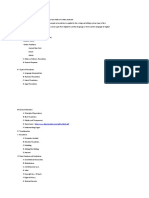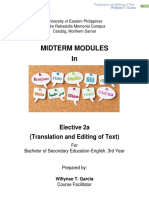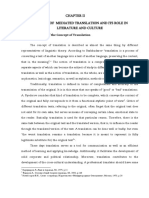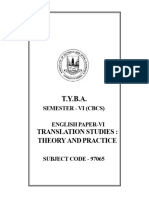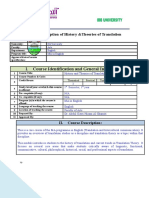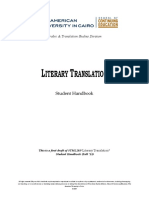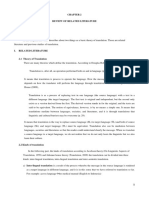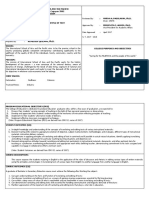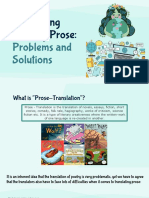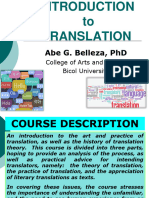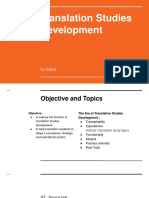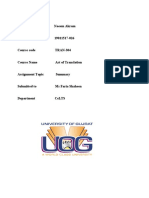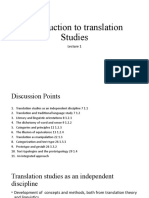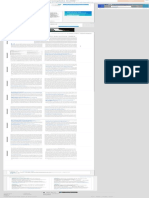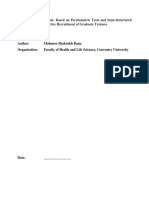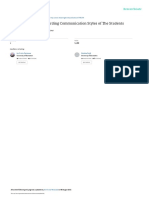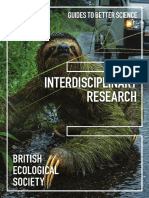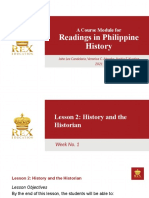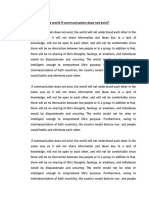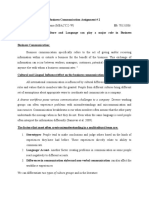Siena College Tigaon Inc.
Service Education Department
Gingaroy, Tigaon, Camarines Sur
COURSE SYLLABUS
Course Name TRANSLATION AND EDITING
Course Description This course is designed to acquaint the students with the theories and principles of translation and editing. It provides students
opportunities to apply their knowledge in translation and editing.
Contact Hours/Week 3 hrs/week (18 weeks, 54 hrs. total)
Prerequisite None
Instructor MARVIN M. SALES, LPT
E-Mail sales.marvin@scti.ph.education
Class Days and Class
Time
Course Outcomes
Course Outcomes
Learning Plan/ Instructional Plan
Time Allotment Intended Learning Outcomes Course Content/Subject Matter, Number of Teaching-Learning Assessment Tasks and Outputs
Hours/ Meetings Activities
At the end of the lesson, the UNIT I: Background Quiz
learners must have: Lesson 1: Introduction
1. defined what translation is. A. Definition of Translation
2. traced the History of B. Early History of Translation
1
�translation from its earliest C. Fidelity vs. Transparency
time up to the contemporary D. Formal Equivalence vs. Dynamic
period. Equivalence
3. differentiated Fidelity from
Transparency
4. debated on the use of formal
equivalence and dynamic
equivalence.
At the end of the lesson, the Lesson 2: Back translation Quiz
learners must have: 1. Definition
1. Define the terms. 2. Popular Back-translators Verbal participation on the
2. Get to know the popular 3. Attributes of a competent translator. discussion on concepts of
back-translators. language and humans
3. Discuss the different
attributes of a competent
translator. Community and language needs
assessment documentation
report
Case analysis
Lesson 3: Types of Translation Quiz
At the end of the lesson, the 1. Interpreting
learners must have: 2. Computer-Assisted Oral participation
1. Enumerate the different 3. Sworn Translation
types of translation. 4. Literary Translation
2. Define the different types 5. Modern Translation
of translation.
2
� 3. Choose at least two types
of translation and use it in
translating a text.
At the end of the lesson, the UNIT II: The History of Western Literary Quiz
learners must have: Translation
1. Discuss the history of 1. Language Interpretation Formative assessment
Western Literary Translation. 2. Technical Translation
2. Enumerate the kinds of 3. Literal Translation Class participation/sharing of
translation used by Westerners. 4. Legal Translation analysis for in-dept discussion
3. Translate a certain text using
the kinds of translation.
At the end of the lesson, the UNIT III: Context Retention
learners must have: 1. Principles of Equivalence
1. Discuss the 2. Baker’s Approach to Translation
Principles of Equivalence Equivalence
; Baker’s Approach to 3. Back Translation
Translation Equivalence; Back 4. Transparency and Fidelity
Translation; Transparency and 5. Equivalence
Fidelity; Equivalence; Theory 6. Theory and Practice
and Practice; Understanding 7. Understanding Jargons
Jargons
At the end of the lesson, the UNIT IV: Transliteration
learners must have: 1. Definition
1. Give a definition of 2. Uses
transliteration. 3. Difference from Transcription
2. Discuss the various uses of
transliteration.
Differentiate transliteration
3
�from transcription.
At the end of the lesson, the UNIT V: Translation Techniques
learners must have: 1. Direct Translation Techniques
1. Enumerate the different a. Borrowing
translation techniques. b. Claque
2. Discuss the different c. Literal Translation
translation techniques. d. Oblique Translation Techniques
3. Use the translation e. Transposition
techniques in translating the f. Modulation
texts in the activities. g. Reformulation or Equivalence
4. Translate a text applying any h. Adaptation
of the techniques. Compensation
At the end of the lesson, the UNIT VI: Press Freedom and Limitation
learners must have: a. Freedom of the Press or Media
b. Status of Press Freedom Worldwide
1. Define press freedom.
c. Limitation or Restriction
2. Discuss the status of press d. Constitutional Guarantees
freedom worldwide. e. Anti-Obscenity Laws
3. Identify the different laws f. Copyright Law
covered by the press freedom. g. Right to Privacy
h. Constitutional Rights
4. Enumerate the different i. National Security
elements of National Security.
5. Relate the laws into the Elements of National Security
happenings on press/media 1. Military
2. Political
people at the present time. 3. Economic
4.Environmental
At the end of the lesson, the UNIT VII: Literary Translation
4
� learners must have: a. Definition
1. Define what literary b. History
translation is. c. Techniques
2. Trace the history of literary d. Purpose
translation.
3. Identify the various
techniques that can be used in
literary translation.
4. Discuss the purpose of
literary translation.
5. Translate a poem using the
techniques in literary
translation.
At the end of the lesson, the UNIT VIII: Proofreading & Copy Editing
learners must have: 1. Definition of terms
1. Define the terms especially 2. Common Proofreading Symbols
proofreading and copy 3. Uses and Importance of Proofreading
editing. Copy editing
2. 2. Familiarize with the
common proofreading
symbols.
3. 3. Discuss with one another
the use sand importance of
proofreading.
4. 4. Proofread and Copyedit
news articles and editorials.
References:
5
�Prepared by:
MARVIN M. SALES, LPT
Instructor
Approved:
JOCELYN C. FEDERIS, LPT, MAED
Program Head
SR. EMILY LALANTACON, O.P, Ph. D
College Dean/President






